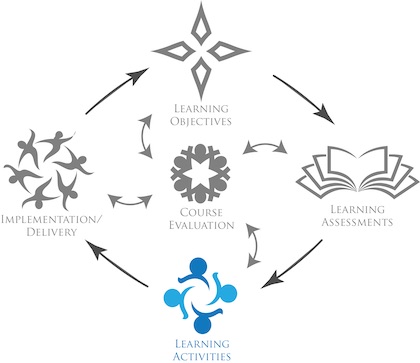Brief Overview
Learning activities, as the name suggests, are activities designed and used by a teacher to bring about or create the conditions for learning.
Learning activities are the resources that help you to achieve the learning objectives of a course or program. They can motivate a learner to participate more actively in their learning, and well-designed learning activities can help you create cognitively heavy learning modules that can produce interesting, meaningful learning.
There are a number of ways in which learning activities can be incorporated in the program. Possible learning activities might include lab experiments, story problems, case studies, role playing, place- and problem-based learning, gamification, virtual learning, augmented reality, branching scenarios, group collaborations via social networks, feature-rich eLearning games, personalized learning paths, and more.
To be effective, learning activities should account for the experience level of the learners and the goals that you want to achieve with the activity. You also need to determine the optimal amount of time that you want to spend on each particular activity to achieve the desired goals. Identifying the media and technology you want to use also contribute to development of effective learning activities.
Finally, using technologies such as big data can now be immensely helpful when creating and revising learning activities. Data can help you design more personalized learning material, identify loopholes in previously created learning activities, assess which kind of activity is right for a particular module, and come up with alternate activities when needed.
Key Links/Examples
- Tools for Learning. Check out the ECTL “Teaching Tools” on our Knowledge Base main page.
- Active/Engaged Learning. Check out the UW LAMP program’s resources.
- Online Learning Activities. Check out University of Illinois-Springfield’s extensive Online Instructional Activities Index
- Lecture-based Learning. Illinois’s Center for Innovation in Teaching and Learning provides tips here.
- Lab-Based Courses. Queen’s University provides guidelines here.
- Large-enrollment Courses. UC-Boulder offers Survivor Strategies: Teaching Large Enrollment Classes
- Discussion-Based Courses. Check out the Online Learning Consortium’s guide to Designing for Discussion-Based Teaching
- Reflective Learning. ACSD makes the case for students’ and teachers’ reflective practice.
- Clemson offers ideas for classroom reflection.
- Writing-to-Learn Activities. CSU’s WAC Clearinghouse provides ideas for helping students use writing to deepen their content knowledge.
- Reducing Plagiarism. Consider ECTL's plagiarism resources page for ideas.
Want more help? Reach out to ECTL staff at wyocourses-inst@uwyo.edu


